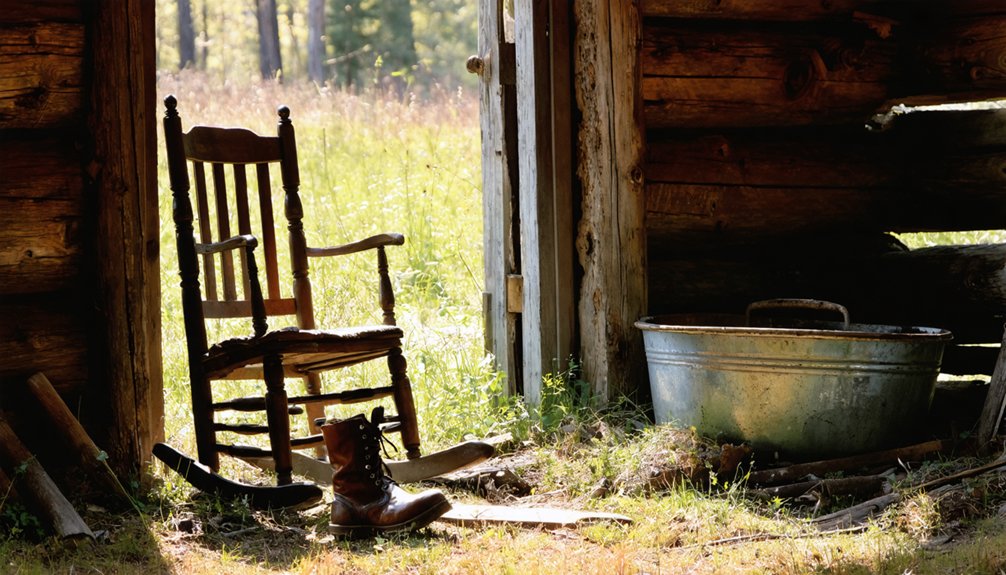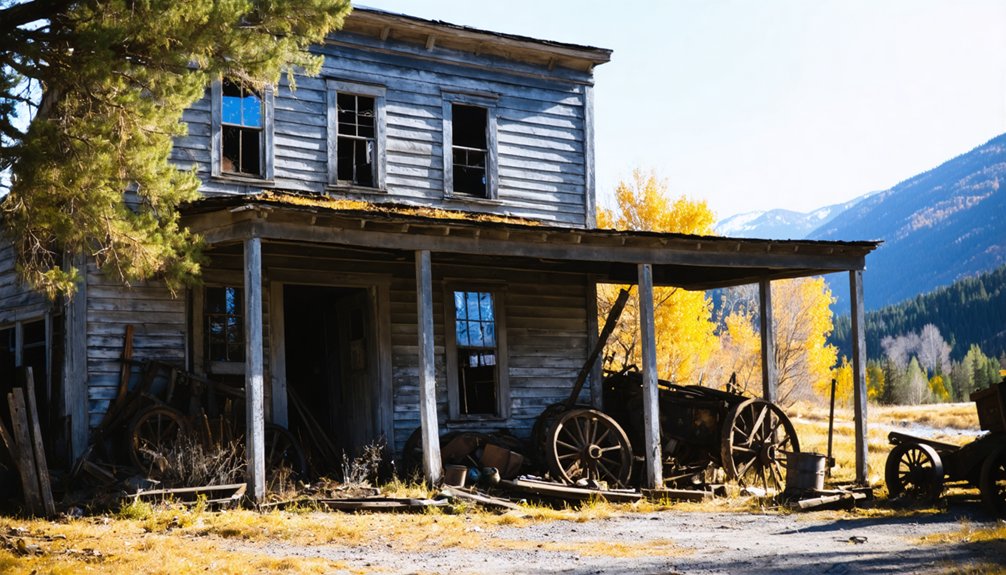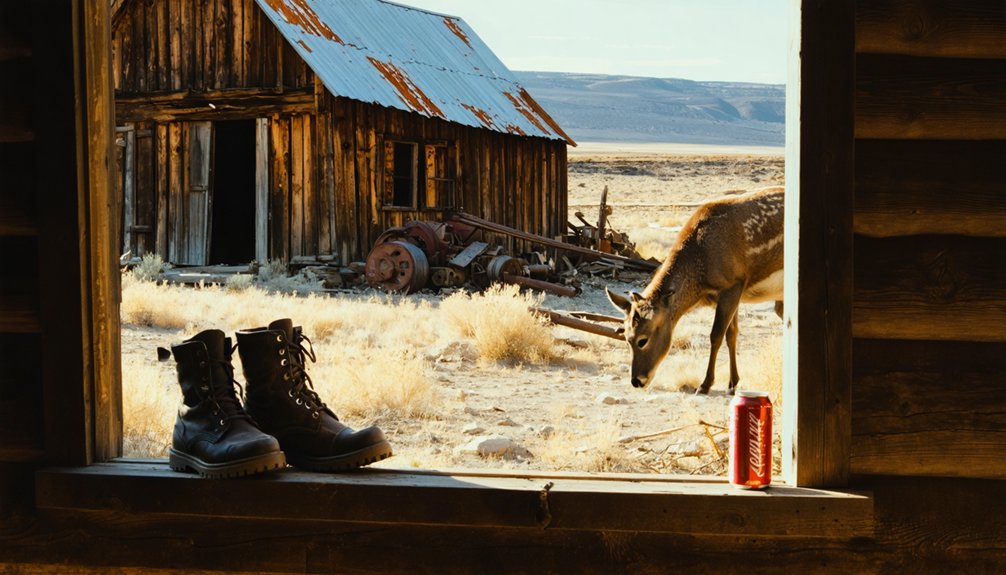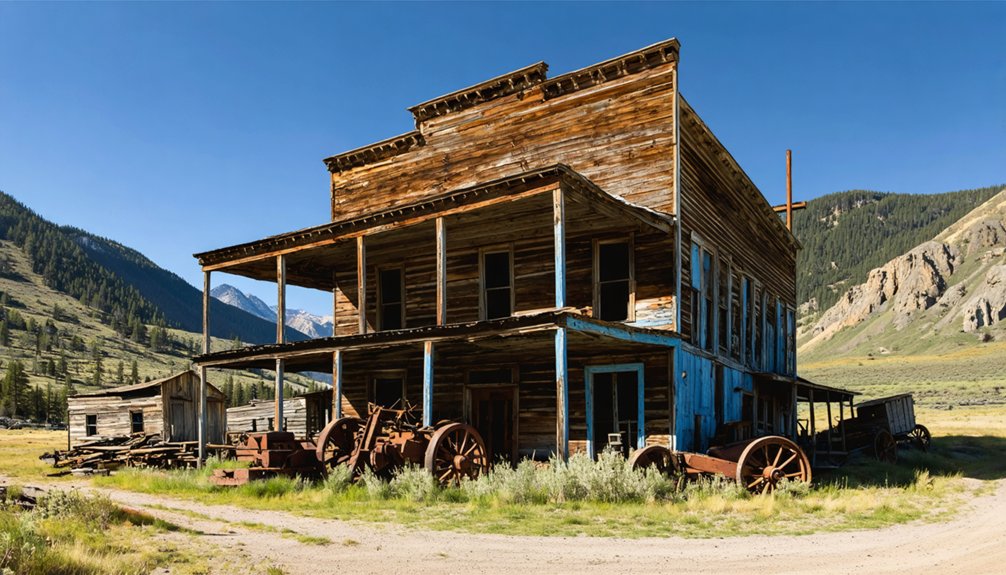You’ll discover Placerville, Idaho’s historic ghost town, in the remote Boise Basin at 4,324 feet elevation. Founded during the 1862 gold rush, it quickly grew to house thousands of miners, with 90 buildings including hotels and saloons. The Great Fire of 1899 devastated the original wooden structures, though residents rebuilt with brick and stone. Today, about 53 people maintain this former boomtown’s heritage, where gold-panning tourists and abandoned buildings tell tales of the American West.
Key Takeaways
- Placerville is a former gold mining boomtown established in 1862, now considered a ghost town with only 53 year-round residents.
- The Great Fire of 1899 destroyed most original wooden structures, leading to rebuilding with brick and stone materials.
- Today’s Placerville features a mix of well-maintained homes, abandoned buildings, and one operating store called “Donna’s Place.”
- The town maintains its historical heritage through tourism activities like gold panning, with remnants of early mining operations still visible.
- Located at 4,324 feet elevation, Placerville served as Idaho’s richest gold-producing region before declining after the mining boom.
The Rush for Gold Begins
Three prospectors – George Grimes, Moses Splawn, and their party – sparked Idaho’s most significant gold rush when they discovered valuable placers on Grimes Creek on August 2, 1862.
After battling the swollen Snake River’s treacherous waters, these determined prospecting parties made their way to Boston Bar near present-day Centerville in the Boise Basin.
Braving the wild Snake River rapids, intrepid gold seekers pushed onward to Boston Bar, driven by dreams of striking it rich.
You wouldn’t believe how quickly word of the gold discovery spread. By December 1862, miners flooded the region, staking the best claims and transforming the wilderness into a bustling frontier. The area would soon become part of Boise Basin County, which emerged as Idaho’s richest gold-producing region.
The settlement rapidly grew to sit at 4,324 feet elevation, offering miners a strategic position to access the surrounding gold-rich terrain.
Prospectors could pocket $8 to $20 daily, with lucky strikes yielding up to $200. Despite harsh winters and water shortages limiting the mining season, the Boise Basin became the Pacific Northwest’s premier gold destination, drawing thousands seeking their fortune.
Building a Mining Community
As gold seekers swarmed into the Boise Basin, Placerville quickly took shape in 1862 as one of the region’s most promising settlements.
You’d find a bustling community infrastructure serving thousands of fortune hunters, with hotels, saloons, and stores lining the streets. The town’s strategic location near three major mining districts made it a hub for mining operations that yielded impressive returns – some prospectors earned up to $200 daily. Outdoor enthusiasts and history buffs continue exploring the area’s historic sites today. The area features old hydraulic workings that still show evidence of early mining techniques.
Here’s what you’d experience in Placerville’s heyday:
- Crowds of miners working claims along Moore’s Creek and Grimes Creek
- The rhythmic pounding of arastras crushing gold-bearing ore
- A thousand residents going about their daily lives, from merchants to miners
Despite water shortages limiting placer mining, Placerville’s community spirit and diverse economy helped it thrive through the challenging early years.
Life in Boom Times
If you’d visited Placerville in the early 1860s, you’d have witnessed the rapid transformation of a mining camp into a bustling town of 90 buildings, complete with saloons, blacksmith shops, and meat markets.
You’d have found miners hauling gold from the surrounding creeks while merchants and traders supplied essential goods to the booming population.
Between shifts at the mines, you’d have joined the diverse crowd of prospectors and settlers gathering at local establishments, where the mix of Chinese immigrants and others from various backgrounds created a uniquely Western frontier atmosphere.
During the town’s peak in 1864, the population swelled to several thousand residents as Placerville served as a vital supply center for the Boise Basin region.
Mining Riches Flow Fast
The discovery of gold in August 1862 transformed Placerville from empty wilderness into a bustling boomtown seemingly overnight.
You’d have witnessed the rapid growth of this gold mining powerhouse as prospectors rushed in from Florence and Auburn, Oregon, creating an economic impact that would shape Idaho’s future.
By 1864, you’d find yourself among 2,500 residents in what had become the region’s largest settlement, until Idaho City took that crown.
The town’s explosive growth brought:
- 90 sturdy houses dotting the landscape
- 13 saloons buzzing with miners’ tales and dreams
- Multiple businesses including blacksmiths, restaurants, and meat markets
While placer mining dominated initially, operations expanded to include hard rock extraction at the Pioneer Mill on Granite Creek, where the region’s first stamp mill crushed ore day and night.
Moses Splawn and his discovery party made the initial gold strike at Boston Bar that sparked this remarkable growth.
The population reached an incredible peak of 5,000 residents by summer 1863, with over 300 buildings sprawling across the bustling townsite.
Daily Life Takes Root
Mining wealth quickly shaped Placerville into a vibrant community where daily life revolved around more than just gold.
You’d find a bustling town of 90 houses and 300 buildings, where five meat markets and seven restaurants kept residents well-fed, while thirteen saloons served as social hubs for both entertainment and business dealings.
As mining families put down roots, you could join community gatherings and dances that helped everyone weather the harsh Idaho winters.
The town’s five blacksmith shops kept mining operations running, while the Pioneer Mill processed the precious ore.
You’d discover a diverse mix of English, Scandinavian, and Chinese residents working the claims and building their lives.
Miners could earn a generous income of fifty to sixty dollars each day for their labor.
Even when winter storms delayed supplies or summer brought water shortages, Placerville’s first territorial post office kept you connected to the outside world.
Following a devastating fire at the century’s end, much of the original town’s character was forever altered.
Commerce and Transportation
You’d find Placerville’s commercial heart bustling with thirteen saloons, hotels, and the Boise Basin Mercantile, which served thousands of miners and residents during the 1860s.
Located in Boise County, this historic mining town was a key commercial destination for the region’s settlers and prospectors.
Wells Fargo established essential stage service in 1864, connecting the town to Wallua and facilitating the movement of goods, gold, and passengers throughout the region.
The town’s carefully planned grid system and central plaza created an organized framework for commerce, setting Placerville apart from typical haphazard mining camps of the era.
Wells Fargo Stage Service
During the late 1860s, Wells Fargo stagecoach service emerged as a vital transportation lifeline in Idaho Territory, particularly after acquiring Ben Holliday’s Overland routes in 1867.
You’d find stagecoach routes connecting Placerville to major hubs like Boise and Salt Lake City, with express cargo moving swiftly between settlements. As you traveled these routes, you’d witness Wells Fargo’s impressive operational scale:
- Up to 85 stations dotting the landscape, positioned roughly 12 miles apart
- A fleet of 50 wagons and 800 horses ready for service
- Iconic Concord coaches arriving fresh from Cheyenne and Salt Lake City
The stagecoach era was brief but transformative, lasting until 1886 when railroad competition forced Wells Fargo to liquidate its Idaho operations, selling off equipment to local operators.
Local Businesses and Trade
As Placerville flourished in the 1860s, its business district took shape around a distinctive town square – an uncommon feature that set it apart from typical mining camps.
You’d find thirteen saloons, seven restaurants, and various shops serving the bustling mining community. The Boise Basin Mercantile anchored local commerce as part of Idaho’s first chain stores, stocking indispensable supplies for miners and travelers.
Trade routes connected Placerville to surrounding mining camps, making it an essential supply hub in the Boise Basin.
Stage lines established by 1864 moved freight and passengers through rough terrain, though seasonal challenges like harsh winters often delayed shipments.
While mules and horses transported goods along difficult roads, the town’s strategic location helped it maintain its position as a significant trading center throughout the gold rush era.
Notable Characters and Events

While many mining towns attracted unsavory characters and lawlessness, Placerville’s most notorious event occurred in June 1865 when musicians Fred Cursons and L. Moulton, along with miner George Wilson, were murdered on their way to Centerville.
In a dark chapter of Placerville’s history, three men met their tragic end on a fateful journey to Centerville in 1865.
The crime shocked the community, especially since Wilson carried significant gold dust.
The aftermath revealed three distinct elements that captivated the town:
- John Williams, a known gunman and gambler, faced arrest but was acquitted
- An angry mob nearly lynched Williams before his trial
- The true killer’s identity remains a mystery to this day
You’ll find the victims’ graves in Placerville Cemetery, where visitors still leave coins as markers – a symbol of how deeply this crime affected the community’s soul and its lasting impact on local history.
The Great Fire of 1899
The devastating 1899 fire brought Placerville’s early mining era to a dramatic end, much like the violent crimes that had shaken the town decades earlier.
You’ll find that this inferno practically destroyed the entire town, leaving only a handful of original wooden structures standing. In the fire aftermath, residents rebuilt with brick and stone instead of wood, forever changing Placerville’s architectural evolution.
A second major blaze struck just ten months later, further transforming this once-bustling mining hub.
While the town experienced a brief revival by 1910, you can see how these fires accelerated Placerville’s decline from a thriving supply center to a quieter community.
Today’s streetscape largely reflects the post-1899 rebuilding efforts, with James McDevit’s city hall standing as a symbol of this pivotal transformation.
Decline of a Mining Empire

Despite Placerville’s commanding start in the 1862 Boise Basin gold rush, you’ll find its mining empire began crumbling by the late 1860s.
The town’s economic changes hit hard as mining challenges mounted:
- Your once-abundant placer claims dried up when limited water supplies and harsh winters cut the mining season short.
- Your promising quartz operations, including the Pioneer Mill, failed despite initial yields of $263,000 from properties like Gambrinus.
- Your mining population dwindled to fewer than 400 by 1870 as Idaho City’s year-round water access drew miners away.
Chinese miners extended some life to the area by working lower-grade deposits and tailings, but they couldn’t stem the decline.
The town that once dominated the basin transformed into a quieter settlement, its dreams of sustained mining prosperity fading into the Idaho wilderness.
Preserving Historical Heritage
Standing as proof of Idaho’s gold rush era, Placerville’s historical buildings and landmarks invite you to step back into the 1860s mining boom.
You’ll find the Boise Basin Mercantile and Magnolia Saloon preserved around the town’s unique square, offering authentic glimpses into frontier life. The mercantile, now a museum on the National Register of Historic Places, showcases mining-era artifacts in its original 1860s setting.
Heritage conservation efforts extend to the hillside cemetery, where you can trace the community’s story through poignant grave markers and memorials.
While modern developments like paved roads and new facilities challenge the town’s historical integrity, community engagement keeps Placerville’s legacy alive. Local residents maintain historic structures and organize weekend museum openings, balancing preservation with the practical needs of today’s visitors.
Modern Day Ghost Town Life

Modern-day Placerville defies typical ghost town expectations, maintaining a small but resilient population of around 53 residents who’ve carved out a unique way of life among the historic buildings and mining remnants.
You’ll find a tight-knit community that embraces modern isolation while preserving their town’s rich heritage.
Daily life revolves around three distinct features:
- “Donna’s Place,” the town’s only store, serves as a crucial hub where you’ll meet locals, including the mayor, sharing stories and town insights.
- Weekend tourism activities, from gold panning to ATV rentals, sustain the local economy.
- Well-maintained homes stand in stark contrast to abandoned structures, reflecting the community’s resilience and commitment to keeping their slice of history alive.
The residents prefer their remote lifestyle, rarely traveling to Boise and finding freedom in their peaceful mountain setting.
Frequently Asked Questions
What Was the Average Daily Gold Yield During Placerville’s Peak Mining Years?
While you’d find gold production varied widely with mining technology advances, successful miners earned $100-200 daily during peak years, though exact average yields weren’t consistently documented in the records.
How Did Winter Weather Conditions Affect Mining Operations in Placerville?
Like a frozen prison, winter’s harsh grip limited your mining season to just ten weeks of spring snowmelt, forcing you’d adapt mining techniques and build extensive ditches to capture precious water.
Were There Any Documented Conflicts Between Native Americans and Placerville Settlers?
You’ll find limited records of direct Native American relations in Placerville, though regional settler conflicts occurred nearby during the Idaho Indian Wars and Nez Perce War between 1874-1878.
What Happened to Placerville’s Chinese Population After the Mining Decline?
You’ll find that most Chinese residents relocated to Boise’s Chinatown by the 1870s, where their cultural contributions flourished through businesses and social organizations, while others dispersed to different mining regions seeking opportunities.
Did Any Famous Outlaws or Lawmen Operate in Placerville During Its Heyday?
You won’t find famous outlaws or legendary lawmen dominating Placerville’s history. The only notable case involves John Williams, a gunfighter acquitted of triple murder in 1865, though he wasn’t widely known.
References
- https://en.wikipedia.org/wiki/Placerville
- https://yellowpinetimes.wordpress.com/2024/03/03/idaho-history-mar-3-2024/
- https://westernmininghistory.com/towns/idaho/placerville/
- http://www.ghosttowngallery.com/htme/placerville.htm
- https://www.youtube.com/watch?v=qETuUsWjeW8
- http://www.llystwrog.com/50plusdc/html/body_idghosttowns.html
- http://idaho.com/history/placerville/
- https://www.youtube.com/watch?v=Gbo_8JrWiWU
- https://outerrealmz.com/the-amazing-ghost-towns-of-central-idaho/
- https://history.idaho.gov/wp-content/uploads/2018/12/0166.pdf



